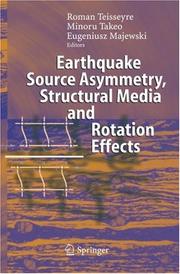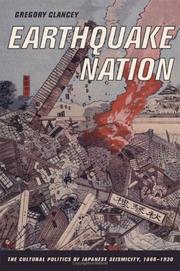| Listing 1 - 5 of 5 |
Sort by
|

ISBN: 1280716746 9786610716746 3540313370 3540313362 364206843X Year: 2006 Publisher: Berlin, Heidelberg : Springer Berlin Heidelberg : Imprint: Springer,
Abstract | Keywords | Export | Availability | Bookmark
 Loading...
Loading...Choose an application
- Reference Manager
- EndNote
- RefWorks (Direct export to RefWorks)
This is the first book on rotational effects in earthquakes, a revolutionary concept in seismology. Existing models do no yet explain the significant rotational and twisting motions that occur during an earthquake and cause the failure of structures. This breakthrough monograph thoroughly investigates rotational waves, basing considerations on modern observations of strong rotational ground motions and detection of seismic rotational waves. To describe the propagation of such waves the authors consider structured elastic media that allow for rotational motions and rotational deformations of the ground, sometimes stronger than translational deformations. The rotation and twist effects are investigated and described and their consequences for designing tall buildings and other important structures are presented. The book will change the way the world views earthquakes and will interest scientists and researchers in the fields of Geophysics, Geology and Civil Engineering.
Earthquakes. --- Shear waves. --- Seismology. --- Seismography --- Geophysics --- Earthquakes --- Distortional waves --- Rotational waves --- S waves --- Secondary waves --- Transverse waves --- Waves, Distortional --- Waves, Rotational --- Waves, S --- Waves, Secondary --- Waves, Shear --- Waves, Transverse --- Elastic waves --- Quakes (Earthquakes) --- Earth movements --- Natural disasters --- Seismology --- Physical geography. --- Geology. --- Civil engineering. --- Geophysics/Geodesy. --- Civil Engineering. --- Engineering --- Public works --- Geognosy --- Geoscience --- Earth sciences --- Natural history --- Geography --- Geophysics. --- Geological physics --- Terrestrial physics --- Physics

ISBN: 9781107297562 9780521828697 9780521123969 9781461944829 1461944821 1107297567 9781107390379 1107390370 0521828694 0521123968 1139883119 9781139883115 1107383943 9781107383944 1107398789 9781107398788 1107387450 9781107387454 Year: 2006 Publisher: Cambridge : Cambridge University Press,
Abstract | Keywords | Export | Availability | Bookmark
 Loading...
Loading...Choose an application
- Reference Manager
- EndNote
- RefWorks (Direct export to RefWorks)
Deep earthquakes (earthquakes with origins deeper than 60 km) are of scientific importance and account for approximately one-quarter of all earthquakes. They are occasionally very large and damaging yet provide much of the data that constrain our knowledge of Earth structure and dynamics. This book opens with an explanation of what deep earthquakes are, their significance to science and how they were first discovered. Later chapters provide a description of deep earthquake distribution and clustering in both time and space; a review of observations about source properties; and a discussion of theories for the origin of deep earthquakes. The book concludes with a comprehensive literature review of terrestrial and lunar deep seismicity. Deep Earthquakes presents a comprehensive, topical, historical, and geographical summary of deep earthquakes and related phenomena. It will be of considerable interest to researchers and graduate students in the fields of earthquake seismology and deep Earth structure.
Earthquakes. --- Seismometry. --- Earthquake prediction. --- Seismic event location. --- Moonquakes. --- Moon quakes --- Quakes (Moonquakes) --- Lunar geology --- Extraterrestrial seismology --- Earthquake location --- Earthquakes --- Location of earthquakes --- Location of seismic events --- Seismology --- Prediction, Earthquake --- Geophysical prediction --- Seismography --- Quakes (Earthquakes) --- Earth movements --- Natural disasters --- Location techniques --- Forecasting --- Prediction --- Measurement --- Extraterrestrial seismology. --- Astrogeology --- Moonquakes

ISBN: 9783540353737 3540353739 9786610627417 1280627417 3540353755 Year: 2006 Publisher: Berlin ; New York : Springer,
Abstract | Keywords | Export | Availability | Bookmark
 Loading...
Loading...Choose an application
- Reference Manager
- EndNote
- RefWorks (Direct export to RefWorks)
This book presents a broad survey of models for critical and catastrophic phenomena in the geosciences, with strong emphasis on earthquakes. It assumes the perspective of statistical physics, which provides the theoretical frame for dealing with complex systems in general. This volume addresses graduate students wishing to specialize in the field and researchers working or interested in the field having a background in the physics, geosciences or applied mathematics.
Earthquakes --- Seismology --- Mathematical models --- Congresses. --- Statistical methods --- Earthquakes -- Mathematical models -- Congresses. --- Electronic books. -- local. --- Seismology -- Statistical methods -- Congresses. --- Geology --- Physics --- Earth & Environmental Sciences --- Physical Sciences & Mathematics --- Dynamic & Structural Geology --- Cosmic Physics --- Seismography --- Quakes (Earthquakes) --- Earth sciences. --- Geophysics. --- Statistical physics. --- Dynamical systems. --- Earth Sciences. --- Geophysics/Geodesy. --- Earth Sciences, general. --- Statistical Physics, Dynamical Systems and Complexity. --- Geophysics --- Earth movements --- Natural disasters --- Physical geography. --- Geography. --- Complex Systems. --- Statistical Physics and Dynamical Systems. --- Mathematical statistics --- Cosmography --- Earth sciences --- World history --- Geography --- Dynamical systems --- Kinetics --- Mathematics --- Mechanics, Analytic --- Force and energy --- Mechanics --- Statics --- Geosciences --- Environmental sciences --- Physical sciences --- Geological physics --- Terrestrial physics

ISBN: 1282358871 1423766644 9786612358876 0520932293 1598759450 9780520932296 9781423766643 9781598759457 9780520246072 0520246071 9781282358874 Year: 2006 Publisher: Berkeley, Calif. ; London : University of California Press,
Abstract | Keywords | Export | Availability | Bookmark
 Loading...
Loading...Choose an application
- Reference Manager
- EndNote
- RefWorks (Direct export to RefWorks)
Accelerating seismic activity in late Meiji Japan climaxed in the legendary Great Nobi Earthquake of 1891, which rocked the main island from Tokyo to Osaka, killing thousands. Ironically, the earthquake brought down many "modern" structures built on the advice of foreign architects and engineers, while leaving certain traditional, wooden ones standing. This book, the first English-language history of modern Japanese earthquakes and earthquake science, considers the cultural and political ramifications of this and other catastrophic events on Japan's relationship with the West, with modern science, and with itself. Gregory Clancey argues that seismicity was both the Achilles' heel of Japan's nation-building project-revealing the state's western-style infrastructure to be surprisingly fragile-and a new focus for nativizing discourses which credited traditional Japanese architecture with unique abilities to ride out seismic waves. Tracing his subject from the Meiji Restoration to the Great Kant Earthquake of 1923 (which destroyed Tokyo), Clancey shows earthquakes to have been a continual though mercurial agent in Japan's self-fashioning; a catastrophic undercurrent to Japanese modernity. This innovative and absorbing study not only moves earthquakes nearer the center of modern Japan change-both materially and symbolically-but shows how fundamentally Japan shaped the global art, science, and culture of natural disaster.
Earthquakes --- Quakes (Earthquakes) --- Earth movements --- Natural disasters --- Seismology --- Social aspects --- Psychological aspects. --- Japan --- Civilization --- 699.84 --- 699.84 Protection against vibration and noise --- Protection against vibration and noise --- Psychological aspects --- J7400 --- J4219 --- J4000.70 --- Japan: Science and technology -- geology --- Japan: Sociology and anthropology -- social policy and pathology -- emergency services (fire department, ambulance services, disaster relief) --- Japan: Social history, history of civilization -- Kindai (1850s- ), bakumatsu, Meiji, Taishō --- architecture. --- building codes. --- building materials. --- building project. --- earthquake safety. --- earthquake science. --- earthquakes. --- ecology. --- environment. --- environmental history. --- great kant earthquake. --- great nobi earthquake. --- infrastructure. --- japan. --- meiji restoration. --- meiji. --- modern japan. --- modernity. --- nation. --- natural disasters. --- nonfiction. --- osaka. --- science. --- seismic activity. --- seismic waves. --- self fashioning. --- structural integrity. --- tokyo. --- traditional architecture. --- western architecture. --- wooden building. --- wooden structures.

ISBN: 1280624280 9786610624287 1402036086 1402035241 9401782733 Year: 2006 Publisher: Dordrecht : Springer Netherlands : Imprint: Springer,
Abstract | Keywords | Export | Availability | Bookmark
 Loading...
Loading...Choose an application
- Reference Manager
- EndNote
- RefWorks (Direct export to RefWorks)
This book points out the need of a multidisciplinary approach in the field of risk assessment and management. It provides an overview of the problems, approaches and common practices directly related to earthquake risk mitigation and, in particular, to the preparation of earthquake emergency plans. Written by a team of specialists from different disciplines, the authors worked together extensively in order to create unity and continuity in the text as a whole. Each topic is illustrated with examples of actual applications taken from the bibliography – including websites with available relevant information. Case studies and information on some relevant international projects are given. Audience This work will be of interest to students and professionals with a basic education in geology, geophysics, geotechnical and civil engineering, system analysis, geography and architecture. It can be used as a textbook for a specialized post-graduate course on the topic.
Earthquake hazard analysis. --- Earthquakes --- Earthquake engineering. --- Earthquakes. --- Disaster relief. --- Emergency management. --- Safety measures. --- Consequence management (Emergency management) --- Disaster planning --- Disaster preparedness --- Disaster prevention --- Disaster relief --- Disasters --- Emergencies --- Emergency planning --- Emergency preparedness --- Management --- Public safety --- First responders --- Disaster assistance --- Emergency assistance in disasters --- Emergency relief --- Emergency management --- Human services --- Quakes (Earthquakes) --- Earth movements --- Natural disasters --- Seismology --- Civil engineering --- Engineering --- Engineering geology --- Shear walls --- Earthquake hazard assessment --- Hazard analysis, Earthquake --- Seismic hazard analysis --- Seismic risk assessment --- Seismic vulnerability assessment --- Earthquake engineering --- Planning --- Preparedness --- Prevention --- Hazard analysis --- Physical geography. --- System safety. --- Human Geography. --- Geophysics/Geodesy. --- Geotechnical Engineering & Applied Earth Sciences. --- Physical Geography. --- Quality Control, Reliability, Safety and Risk. --- Anthropo-geography --- Anthropogeography --- Geographical distribution of humans --- Social geography --- Anthropology --- Geography --- Human ecology --- Safety, System --- Safety of systems --- Systems safety --- Accidents --- Industrial safety --- Systems engineering --- Geophysics. --- Geotechnical engineering. --- Quality control. --- Reliability. --- Industrial safety. --- Human geography. --- Industrial accidents --- Industries --- Job safety --- Occupational hazards, Prevention of --- Occupational health and safety --- Occupational safety and health --- Prevention of industrial accidents --- Prevention of occupational hazards --- Safety, Industrial --- Safety engineering --- Safety measures --- Safety of workers --- System safety --- Dependability --- Trustworthiness --- Conduct of life --- Factory management --- Industrial engineering --- Reliability (Engineering) --- Sampling (Statistics) --- Standardization --- Quality assurance --- Quality of products --- Engineering, Geotechnical --- Geotechnics --- Geotechnology --- Geological physics --- Terrestrial physics --- Earth sciences --- Physics
| Listing 1 - 5 of 5 |
Sort by
|

 Search
Search Feedback
Feedback About
About Help
Help News
News